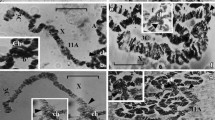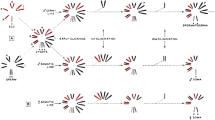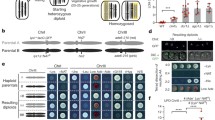Abstract
A transmissible dicentric chromosome was recovered in Drosophila melanogaster. The radiation-induced secondary chromosome rearrangement consists essentially of the entire Y and fourth chromosomes joined by 2R heterochromatin. The Y S · Y L 2Rh4 · chromosome pairs with the X and the free fourth chromosome to form a trivalent in meiosis that is unusual because it forms few chromosome bridges in primary spermatocytes and is transmitted at high frequency. We suggest that the orientation of the weaker fourth chromosome kinetochore eventually fails when opposing the stronger Y kinetochore so that the Y S · Y L 2Rh4 · moves to the pole to which the Y kinetochore is oriented. There is however an increased frequency of sex chromosome nondisjunction (14%) and of chromosome laggards (6%) in primary spermatocytes; the frequency of exceptional progeny of males containing the Y S · Y L 2Rh4 · was 7.44% compared with 0.25% in the controls. Disruption of normal sex chromosome disjunction also occurs in females containing the Y S · Y L 2Rh4 · and a compound X chromosome; the frequency of exceptional progeny was 2.55% versus 0.91% in the controls. Chromosome nondisjunction appears to occur when orientation of the X and Y kinetochores to the same pole is stabilized through tension by the orientation of one or both fourth chromosome kinetochores to the opposite pole. During anaphase, the orientation of the fourth chromosome kinetochore of the Y S · Y L 2Rh4 · appears to fail and the X and Y S · Y L 2Rh4 · chromosomes move to the same pole. Y S · Y L 2Rh4 · chromosome laggards occur with both the Y and fourth chromosome kinetochores amphitelically oriented. This orientation appears to be stable as a result of equal opposing forces toward opposite poles.
Similar content being viewed by others
References
Ault JG, Lin HP, Church K (1982) Meiosis in Drosophila melanogaster. IV. Conjunctive mechanism of the XY bivalent. Chromosoma 86:309–317
Baker BS, Carpenter ATC, Esposito MS, Esposito RE, Sandier L (1976) The genetic control of meiosis. Annu Rev Genet 10:53–134
Church K, Lin HP (1985) Kinetochore microtubules and chromosome movement during prometaphase in Drosophila melanogaster spermatocytes studied in life and with the electron microscope. Chromosoma 92:273–282
Hartl DL, Hiraizumi Y (1976) Segregation Distortion. In: Ashburner M, Novitski E (eds) The genetics and biology of Drosophila, vol. 1b. Academic Press, New York, pp 615–666
Henderson SA, Koch CA (1970) Co-orientation stability by physical tension: A demonstration with experimentally interlocked bivalents. Chromosoma 29:207–216
Hilliker AJ (1976) Genetic analysis of the centromeric heterochromatin of chromosome 2 of Drosophila melanogaster: deficiency mapping of EMS-induced lethal complementation groups. Genetics 83:765–782
Lin HP, Ault JG, Church K (1981) Meiosis in Drosophila melanogaster. I. Chromosome identification and kinetochore microtubule numbers during the first and second meiotic divisions in males. Chromosoma 83:507–521
Lin HP, Ault JG, Kimble M, Church K (1984) Meiosis in Drosophila melanogaster. V. Univalent behavior in In(l)sc4Lsc8R/BsY males. Can J Genet Cytol 26:445–458
Lindsley DL, Grell EH (1968) Genetic variations of Drosophila melanogaster. Carnegie Inst Wash Publ 627
Lindsley DL, Sandler L, Baker BS, Carpenter ATC, Denell RE, Hall JC, Jacobs PA, Miklos GLG, Davis BK, Gethmann RC, Hardy RW, Hessler A, Miller SM, Nozawa H, Parry DM, Gould-Somero M (1972) Segmental aneuploidy and the genetic gross structure of the Drosophila genome. Genetics 71:157–184
Lyttle TW (1984) Chromosomal control of fertility in Drosophila melanogaster. I. Rescue of T(Y;A)/bb1158 male sterility by chromosome rearrangement. Genetics 106:423–434
McClintock B (1943) Maize genetics. Yearbook Carnegie Inst Wash 42:148–152
McClintock B (1944) Maize genetics. Yearbook Carnegie Inst Wash 43:127–135
Moens PB (1978) Kinetochores of grasshoppers with Robertsonian fusions. Chromosoma 67:41–54
Moens PB (1979) Kinetochore microtubule numbers of different sized chromosomes. J Cell Biol 83:556–561
Muller HJ (1940) An analysis of the process of structural change in chromosomes of Drosophila. J Genet 40:1–66
Nicklas RB, Koch CA (1969) Chromosome micromanipulation. III. Spindle fiber tension and the reorientation of mal-oriented chromosomes. J Cell Biol 43:40–50
Novitski E (1952) The genetic consequences of anaphase bridge formation in Drosophila. Genetics 37:270–287
Rickards GK (1983) Orientation behavior of chromosome multiples of interchange (reciprocal translocation) heterozygotes. Annu Rev Genet 17:443–498
Sears ER, Camara A (1952) A transmissible dicentric chromosome. Genetics 37:125–135
Sturtevant AH, Beadle GW (1936) The relations of inversions in the X-chromosome of Drosophila melanogaster to crossingover and disjunction. Genetics 21:554–604
Yamamoto M (1979) Cytological studies of heterochromatin function in the Drosophila melanogaster male: autosomal meiotic pairing. Chromosoma 72:293–328
Yamamoto M, Miklos GLG (1978) Genetic studies of heterochromatin in Drosophila melanogaster and their implications for the functions of satellite DNA. Chromosoma 66:71–98
Zinkowski RP, Vig BK, Broccoli D (1986) Characterization of kinetochores in multicentric chromosomes. Chromosoma 94:243–248
Author information
Authors and Affiliations
Rights and permissions
About this article
Cite this article
Ault, J.G., Lyttle, T.W. A transmissible dicentric chromosome in Drosophila melanogaster . Chromosoma 97, 71–79 (1988). https://doi.org/10.1007/BF00331796
Issue Date:
DOI: https://doi.org/10.1007/BF00331796




